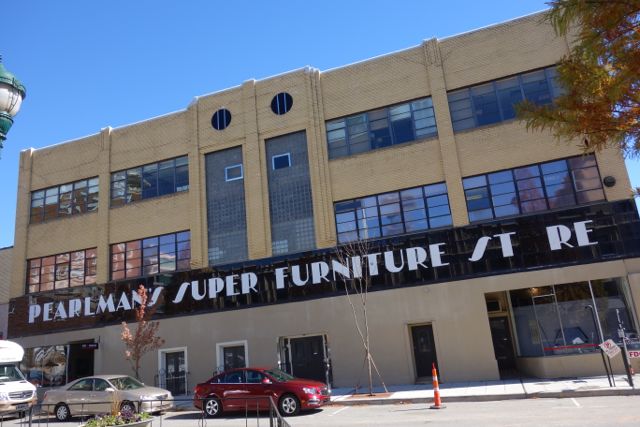
Before arriving in Raleigh, the final destination of this cross-country road trip, we stopped in Asheville, one of those places often found alongside the likes of Athens, Georgia and Marfa, Texas in clickbait slideshows about America’s Coolest Cities of Under 100,000 People. It didn’t answer my long-standing question about who’s doing the clicking and why (coolness or low population; you kind of have to choose one), but I could see why it impresses visitors: it has well-regarded bookstores; it has an architecturally sound and human-scaled downtown (still an astonishing novelty to so many Americans); it has a pinball museum (closed, alas, when we passed by); it has a confectioner who makes shoes out of chocolate.
I didn’t leave with a chocolate shoe, but I did leave with a copy of Lawrence Osborne’s Paris Dreambook purchased, after flipping through it over a generous cheese plate, from the well-curated and highly explorable Battery Park Book Exchange and Champagne Bar (the name alone…), located in a restored shopping arcade somewhat reminiscent of the Bradbury Building back in Los Angeles. Despite having sworn off purchasing books in the months before my move to Korea, I do make exceptions for volumes on cities (professional interest, surely you understand), especially when I personally like the writer (and my interview with Osborne about his Bangkok book remains one of my very favorites from the Marketplace of Ideas days).

Apart from Quail Ridge Books, an event-intensive strip-mall bookstore beloved of no less a locally raised man of letters than David Sedaris (whose signed portrait, hung in the bathroom, reads “I was a monster in 2009”), Raleigh, or at least my experience of Raleigh, seemed to me less about books than about food. Calvin Trillin wrote at length about the struggle for the soul of North Carolinian barbecue in the New Yorker just the other day, naming Raleigh as “the line of demarcation that separates the two principal schools” of that culinary art form.
But ironically, North Carolina counts as the sole barbecue-oriented state we passed through on our road trip in which we ate no barbecue at all: we had it in Texas, we had it in Arkansas, and we had it in Tennessee, but we wholly missed out on both eastern North Carolina’s version, “where barbecue means the whole hog, chopped, with a vinegar-based sauce that is flavored with pepper,” and western North Carolina’s version, which “uses only pork shoulders, chopped (or, sometimes, sliced), with a sauce that is also vinegar-based but has been turned pinkish by the addition of ketchup or tomato sauce.”
We did, however, eat Korean food, or in any case an intriguing local version of Korean food. After ten days on the road, I’d worked up a mighty craving for even a simple kimchi jjigae (or especially a simple kimchi jjigae), and so we stopped in for lunch at Kimbap, a “Korean-inspired” cafe in what I understand to be the Raleigh’s most interesting current food neighborhood outside downtown. If the menu offered kimbap I didn’t see it, but the dishes we did find provided a tasty experience at the intersection of traditional Korean food and hardcore North Carolina locavorism. (Its kimchi had a refreshingly vinegary taste — a distant echo, perhaps, of the eastern North Caroninian love of the stuff in their barbecue?)

We had a chat with the chef, a Korean-born, Michigan-raised adoptee who surprised us with the revelation that she’d never once set foot in the land of her ancestors (not to mention the land of our next residence) after her adoption. I insisted that she visit, if only because she seemed like the ideal person to enjoy a food tour there, but Kimbap has cleared the bar of two and a half years in business, keeping her busier and thus less able to travel than ever with its ongoing demonstration of the apparent viability of selling Korean cuisine to Raleighites.
But the market hasn’t yet reached a saturation point, as indicated by the restaurant’s chopsticks, which come in sleeves printed with directions for how to use chopsticks. If I’d seen that in California, I’d have taken it as an attempt at irony, but North Carolina didn’t strike me as a particularly ironic place. Even there, though, I wonder how long we’ll see this sort of thing. I can’t think of a single American friend of my generation unable to eat with chopsticks, but I get the sense that Asia itself hasn’t yet got word about how thoroughly their stateside usage has spread.
My own unhesitant (if not unusually skillful) chopsticking has drawn expressions of astonishment from certain Koreans in both their homeland and mine, a reaction often revealing more surprise than the one I get when I actually speak Korean — though I did score a twofer once when, at a Koreatown Korean Chinese restaurant (a distinct variant of Chinese cuisine, with dishes as signature as though much more defined than American Chinese food’s orange chicken and chop suey), I explained in that language to the middle-aged lady who suddenly appeared at my side two-handedly proffering a fork that, thank you, but I didn’t need one.

We ate more often downtown, and you can’t talk about downtown Raleigh food, so I gather, without taking about Ashley Christensen, the well-known chef who runs seven popular bars and restaurants in the city. We got to four of them in the span of two days without really trying: Beasley’s Chicken + Honey, a sort of North Carolinian Roscoe’s Chicken and Waffles; Chuck’s right next door, a specialty hamburger joint boasting myriad French-fry dipping sauces; Fox Liquor Bar, a brick-walls-and-bare-bulbs sort of place underneath Beasley’s and Chuck’s; and Poole’s, a new-wave diner open late enough for us to hit up after an event (although “late” in this case means midnight, a sign that downtown Raleigh has a little way to go yet, though huge swaths of Los Angeles suffer exactly the same problem).
Of course, I imagine that some hardcore Raleigh eaters and drinkers disdain Christensen’s restaurants in the same way that some hardcore Portland eaters and drinkers disdain the McMenamin’s establishments. But you know what? I’ve drawn great pleasure indeed from every McMenamin’s place I’ve visited, and at this point a visit to Portland wouldn’t feel complete without at least one. (It does boggle my mind, though, that with the Anderson School they’ve expanded into Bothell, Washington, the crappy suburb next to the crappy suburb where I went to high school.) Maybe, a few Raleigh trips from now, I’ll come to feel the same way about the Christensen empire.

Raleigh’s other urban amenities I find it a bit harder to judge. Like many midsize American cities, it lacks even the most basic rapid transit system, though discussions have begun; in the doorway of a gift shop I found brochures detailing the pros and cons of rail versus bus rapid transit, though nothing will actually happen until 2026 at the earliest. I didn’t get the chance to ride the R-LINE, a nifty-looking free downtown circulator bus (albeit one that only goes in one direction and only comes every fifteen minutes). But we did stop by the also-free City of Raleigh Museum, whose maps and models on display give a sense of the city’s layout and how it developed. (I wish every city had one of those; I’d make them the first stop as a rule.)
As always, on American road trips or any other form of travel, the most memorable things come unexpectedly. I put the call out on Twitter for recommendations from Raleigh urbanists, and someone replied to suggest the Contemporary Art Museum Raleigh’s kissa, held weekly on the building’s bottom floor and modeled after the 1950s Japanese kissaten, “bars and cafes where music lovers could share their record collections with devoted and curious listeners.”
On the week we happened to attend, we drank wine while listening to selections from the formidable collection of Marshall Wyatt, proprietor of vintage-Americana label Old Hat Records, concluding our journey through America’s present with a plunge into America’s past. Toward the end of the evening, Wyatt pulled out a piece of vinyl to which he said he wanted to give a special introduction, one that would let him “say the three words every collector longs to say: only. Known. Copy.” Misuse of the word “unique,” a habit common to American speech, has started to grate on me after thirty years here (maybe that along has driven me to Korea), but here we had a genuine opportunity to use the word: a unique recording in a unique country.